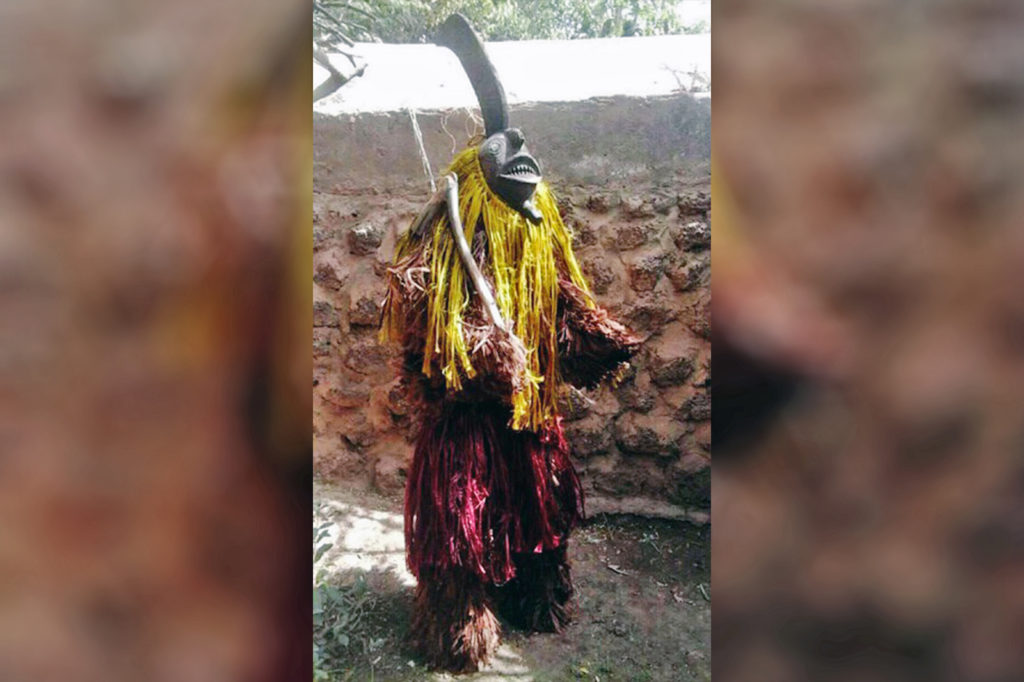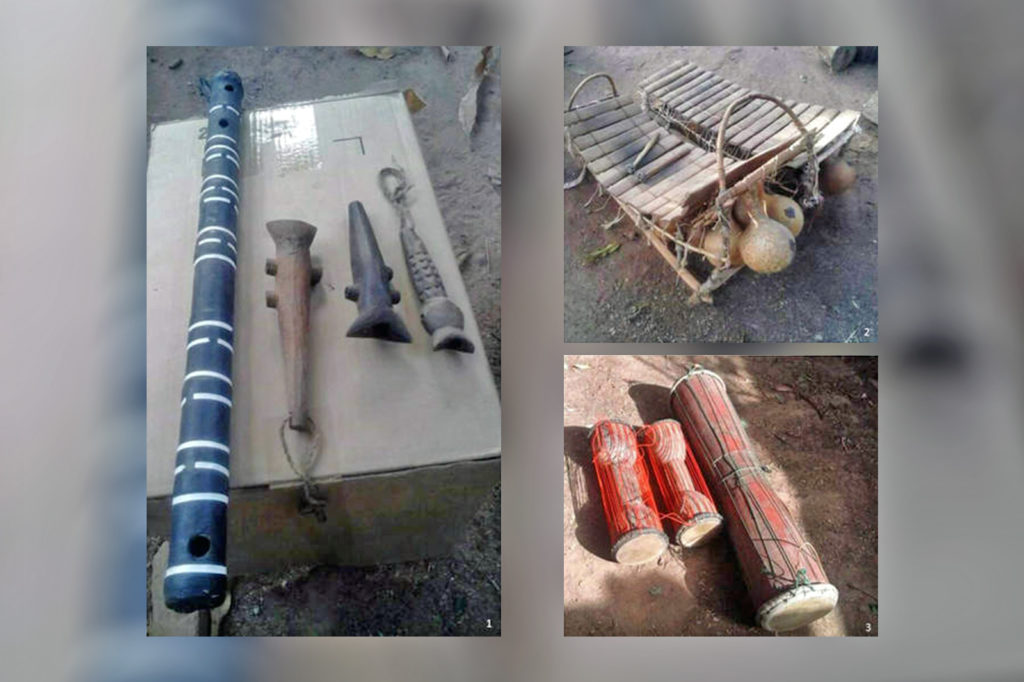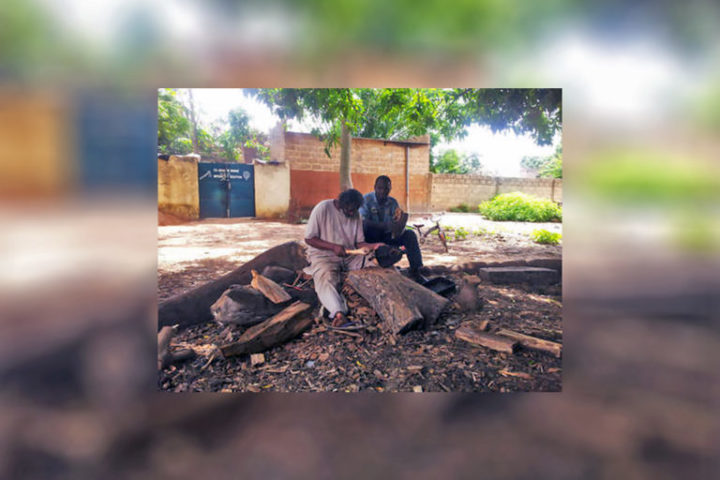Alban Kaboré, who works at the Regional Office for Culture in the Boucle du Mouhoun region of Burkina Faso, has created an exhibition entitled Le musée ambulant de Bomavé (Bomavé’s travelling museum) in collaboration with Burkinabe sculptor Bomavé Konaté. The project’s main objective is to meet with partners who are passionate about African culture and African masks in order to create a Living Arts Museum.
Since 2016, with support from UNESCO, Burkina Faso has conducted a major campaign to inventory its intangible cultural heritage. When I led the team in charge of conducting the inventory in the Balé province, we discovered a sacred mask sculpting technique practised by the Konaté family in the village of Oury. That was when I met sculptor Bomavé Konaté, named a ‘Living Human Treasure’ by Burkina Faso in 2015. Bomavé Konaté is the oldest member of the Konaté family and therefore the keeper of the mask-making tradition. After our first encounter, I returned to Oury to talk more with the sculptor about the sacred mask tradition. He showed me a neglected hut where he keeps masks and statues that have been used in rituals and returned to their creator. Bomavé Konaté also explained that among the Konaté blacksmith-sculptors, every head of the family has a hut where he stores objects that have been returned to him. I was deeply troubled by seeing objects of such great cultural value suffer this fate, at the mercy of dust, sun, and rain. When I shared my dismay, Bomavé told me of his ambition to create a place where these objects could continue to have a voice.
After talking with the sculptor at length about the tradition of sacred masks and how to preserve, honour, and share them, I raised the possibility of creating a museum to provide these objects with a new setting in which they could express themselves and to share the accompanying stories, tales, and legends with future generations.
Bomavé Konaté shared my enthusiasm for this project and we decided that this ‘Living Arts Museum’ would be built in Boromo, capital of the Balé province.
Since the project is costly, we have created an exhibition, Bomavé’s travelling museum, to promote the museum’s creation, explain its concepts, and meet with potential investors and partners. As we cannot manage the project alone, anyone who would like to help make it a reality can become a partner by signing a mutual agreement. The museum’s exhibitions will then be created based on a consensus.
Bomavé’s travelling museum includes 20 assembled masks worn by mannequins and accompanied by musical instruments (drums, flutes, and balafons). The pieces are accompanied by an explanation of the different functions of the mask, its provenance, and the stories, tales, and legends associated with it. With workshops run by Bomavé Konaté, Bomavé’s travelling museum also provides an opportunity for people to come together and learn how to sculpt wood. Finally, talks and discussions are organised to promote the creation of the Living Arts Museum.

The ‘crazy’ mask is the only one designed to look like a person but with a horn on its head. It symbolises strength, joy, and freedom. It is said that to live well, one must live like a ‘crazy’ person. But a ‘crazy’ person is different from a person with mental problems. A crazy person possesses the spirit of a higher power that human beings cannot see. It is said that only crazy people tell the truth. (© Alban Kaboré)

The ‘monkey’ mask is the oldest mask and symbolises evolution. All human beings, regardless of gender, title, social class, etc., must learn to evolve. (© Alban Kaboré)

- A transverse flute and three straight flutes
- An arc balafon and a flat balafon
- Two armpit drums and a long drum
These traditional musical instruments accompany the mask whenever it appears. (© Alban Kaboré)
Sacred mask sculpture in Burkina Faso
In Burkina Faso, the blacksmith is the master of iron and fire. His community turns to him as a last resort to resolve situations such as family and territorial disputes, to cast or remove a spell from a person, place, or thing, or to purify the village. Because of this, the blacksmith holds a unique cultural rank and makes sacrifices to decide between disputing parties. The blacksmith is also in charge of making the daba, a tool farmers use to plough and weed their fields. With a wooden handle on top attached to an iron spade sculpted by the blacksmith, it is an essential tool in these primarily agricultural communities.
In addition to working with metal, blacksmiths also know how to work with wood and sculpt masks for their own families or families from other communities. Blacksmith-sculptors do not sign their masks, and despite the challenge of making them, ask only for a chicken in exchange. The chicken is then used in rituals to sacralise their work and the objects they make.
Masks, just like African statues, are seen as beings that borrow human bodies to speak, and exchanging them for money is strictly forbidden. This rule also holds true for the sculptor. Objects used in cultural rituals must be desacralised before they can be exchanged. Anyone who possesses these cultural objects and no longer wants to perform the rituals associated with them must send them back to the person who made them. That is why many blacksmith-sculptors like Bomavé Konaté have a large number of masks and statues in their possession.
The Institut Français in Ouagadougou was scheduled to host Bomavé’s travelling museum this May for a one-month exhibition. However, due to a terrorist attack on 2 March that took place near the exhibition site, visitors will have to wait until September 2018 to walk among Burkina Faso’s sacred masks. We then hope to bring Bomavé’s travelling museum to as many countries as possible in order to share the idea of a Living Arts Museum with a wider audience.
–
Born in 1958 in the village of Oury, 30 km from the city of Boromo in Burkina Faso, artist Bomavé Konaté comes from a family of blacksmiths. After choosing to work with wood rather than iron, he became an iconic figure in Burkinabe sculpture. In 2015, Burkina Faso’s Ministry of Culture, Arts, and Tourism named him a ‘Living Human Treasure’. This honour is the government’s recognition of those who possess knowledge and expertise they can share with future generations.
Alban Kaboré was born in 1978 in Divo, Côte d’Ivoire and completed secondary school in Burkina Faso. After several years of working odd jobs, travelling, and two years of training at the National School of Administration and Magistracy (ENAM) in Burkina Faso, the culture enthusiast obtained a degree as a museum docent. Alban Kaboré currently works at the Regional Office for Culture, Arts, and Tourism in the Boucle du Mouhoun region, in Dédougou. As part of an office that supports local initiatives and the culture and tourism industries, his mission is to assist cultural and tourism actors in developing their projects.
If you would like to receive more information about this project, to support the creation of the Living Arts Museum, or to host Bomavé’s travelling museum in your country, please contact Mr Alban Kaboré via email or telephone number: +226 70 96 65 24.
